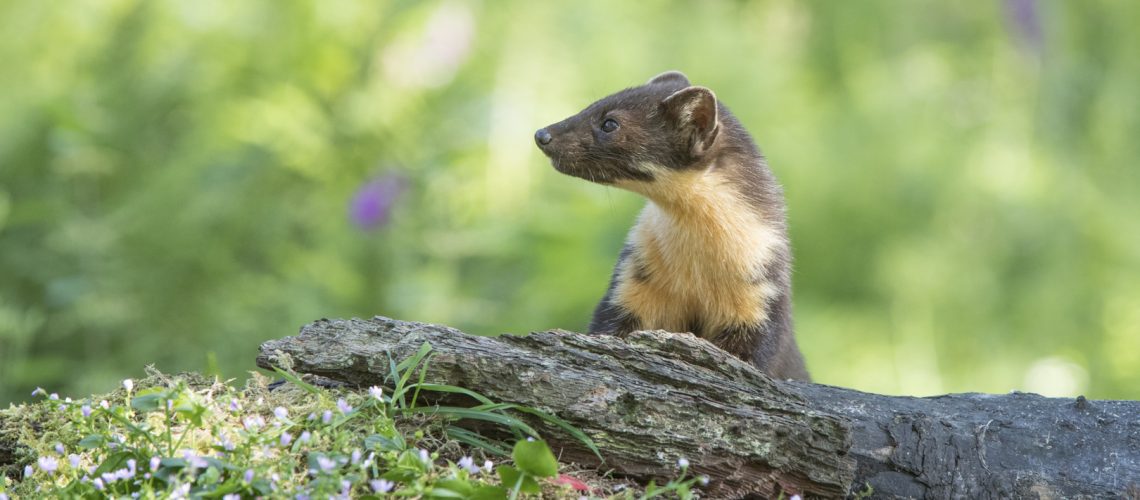
For once we have an environmental good news story – thanks to Britain’s carnivores. In recent history, there was a very real danger of saying goodbye to a sizeable number of our predatory mammals: pine marten, polecat, otter and wildcat –to add to the long-gone lynx, wolf and brown bear. Hunting, predator control, use of toxic chemicals and habitat loss were the key factors in the decline of our native carnivores. How exciting it is that things are now looking up for this once beleaguered group of mammals.
With the exception of the Scottish wildcat, our carnivores are all pretty much on a healthy trajectory, which for some species would have been unthinkable in the latter part of the last century. This bounce back is confirmed in a paper written earlier this year by Dr Katie Sainsbury, then a PhD student at the University of Exeter and supported by Vincent Wildlife Trust. “The recovery of predatory mammals in Britain shows what happens when you reduce the threats that animals face. For the most part, these species have recovered by themselves.” Exeter’s Professor Robbie McDonald explains.
Otters are in almost every river across Britain; a remarkable recovery since the banning of organochlorines. Polecats are spreading from their Welsh stronghold – all by themselves. Badgers have doubled in number since the 1980s and the fox population has risen since the 1960s, though a recent decline could be linked with dwindling rabbit numbers. Finding out the status of stoats and weasels, however, remains tricky. As Professor McDonald explains: “These small and fast-moving predators are hard to see and to survey.” Ironically, the best means of monitoring them is from the records of gamekeepers who trap them, although research is currently being carried out by Vincent Wildlife Trust into new non-invasive monitoring techniques.
Wildcats, sadly, are excluded from this success story. Today, the few remaining wild living cats in Scotland are in dire straits, their decline linked largely to interbreeding with domestic cats. The feasibility of reintroduction programmes for this species is being investigated.
For me, one of the greatest carnivore good news stories is the return of the pine marten to mid-Wales, and on a cold October morning, I went in search of arguably the most endearing carnivore on the planet. I am ignoring the fact that using the word endearing for such a consummate hunter is somewhat oxymoronic.
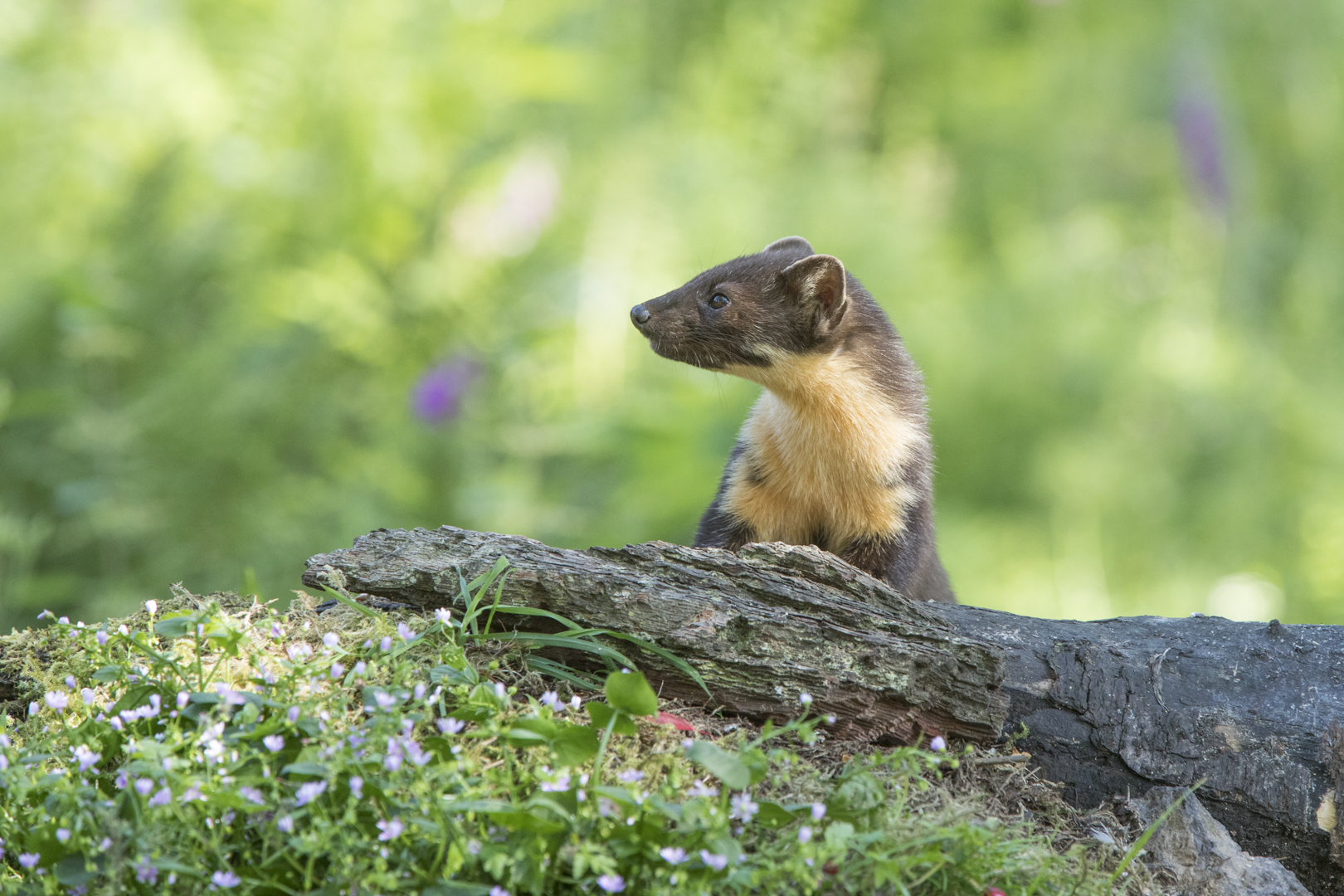
Photo: Pine marten ©Robert Cruickshanks
October is an agreeable time of year to take a woodland walk. Inhaling the crisp, autumn air and savouring the cheery blue skies is always uplifting – especially if you are in the ‘Celtic rainforest’ of the Rheidol Valley, a landscape-to-die-for in mid-Wales.
I was last here four years ago, when the first pine martens were brought from Scotland by Vincent Wildlife Trust with the support of Scottish Natural Heritage and what is now Forestry and Land Scotland, to reinforce a local marten population heading for extinction. Fifty-one adult martens and four seasons of kits later and I know that I have been part of a landmark project – the first carnivore recovery programme of its size in Britain. But it isn’t over – Trust staff and local volunteers continue to check the progress of this new marten population.
We join an old lead mining track just above the valley floor and I gaze across the Afon Rheidol as it winds slowly along a classic glacial valley towards the sea. At this point the river has been dammed, and the reservoir is an uninviting ink black. Across the water, I can just make out the route of the steam railway chiselled into the near vertical hillside; a railway built to transport mined metals and timber, but today carrying thousands of visitors each year to this tourist honeypot. Surrounding me is a mix of dismal conifer plantation and the more welcoming Atlantic woodlands. A band of ominous dense cloud appears from out of the blue and engulfs the tree canopy. We leave the track and head into the forest.

Woodland in the Cambrian Mountains, where pine martens were released between 2015 and 2017 ©Nick Upton
Our mission is to find evidence of martens in this area and we have two tasks. We must gather up a number of trail cameras and ‘hair tubes’ hidden deep in the woodland, and we will be searching for marten droppings known as scats. Any scats we find will be sent for DNA checking to see if the dropping is from one of the original Scottish martens.
Unlike most of its cousins, the pine marten has a convenient lavatorial habit of marking its territory along paths and at points where paths cross. To me, marten scats fall into two categories: those that could only be marten, unless they are fox, and those that could really be anything.
The scats can have a distinctive marten aroma – sometimes. The problem is that martens are omnivores and the smell of the scat is influenced by diet. If the smell isn’t conclusive, there is always the characteristic curled cylindrical shape. I have possibly collected most letters of the alphabet formed from marten poo in my time as a scat hunter. A marten’s curious habit of wiggling its bottom when scatting may be responsible for such calligraphic skill. Then there is the colour – scats are usually black but can be brown, or even red if cherries or plums are on the menu. So really much of it comes down to gut instinct, if you pardon the pun.
Today, I cross my fingers discreetly in the hope of being rewarded for my commitment to marten conservation. Wonderful as it is to find a neat pile of faeces nestling on a path-side boulder, perhaps today I may actually see a pine marten and not just field signs. Although largely nocturnal, martens do occasionally venture out during the day. Perhaps I will be lucky, but I won’t be putting money on it.
Progress is slow, concentration is high, hypothermia is lurking. Very soon something catches my eye. A neatly coiled scat sits rather splendidly on a small rock at the edge of the path. It looks promising but possibly a little too large. I take a sniff and reel back from the pungent, musky smell of fox – and one that has not long passed this way. Fox can wrong-foot the best scatologist.
Finding scats in mid-Wales is more of a challenge than in Scotland because there are far fewer martens, and they have large territories and live a mostly solitary existence. We trek onwards, passing an avalanche of scree: a monument to this valley’s industrial past. A little further on and I hear a shout. ‘Hurrah! Found one.’ My colleague has spotted a muddy-looking blob deposited on a drain cover. So often, martens scat on features in the landscape: a tree stump, a boulder, a drain cover. Beetle cases bring a sparkle to this splodge, suggesting possible marten origin. This is our first potential scat and I am ridiculously excited. It means one of our rarest mammals could be watching me right now. We carefully scoop the scat into a plastic bag with the aid of two lolly sticks – no expense spared in terms of field equipment. Safely stashed away, we continue our expedition in silent contemplation. I make a mental note to suggest we advertise scat hunting as a form of mindfulness.
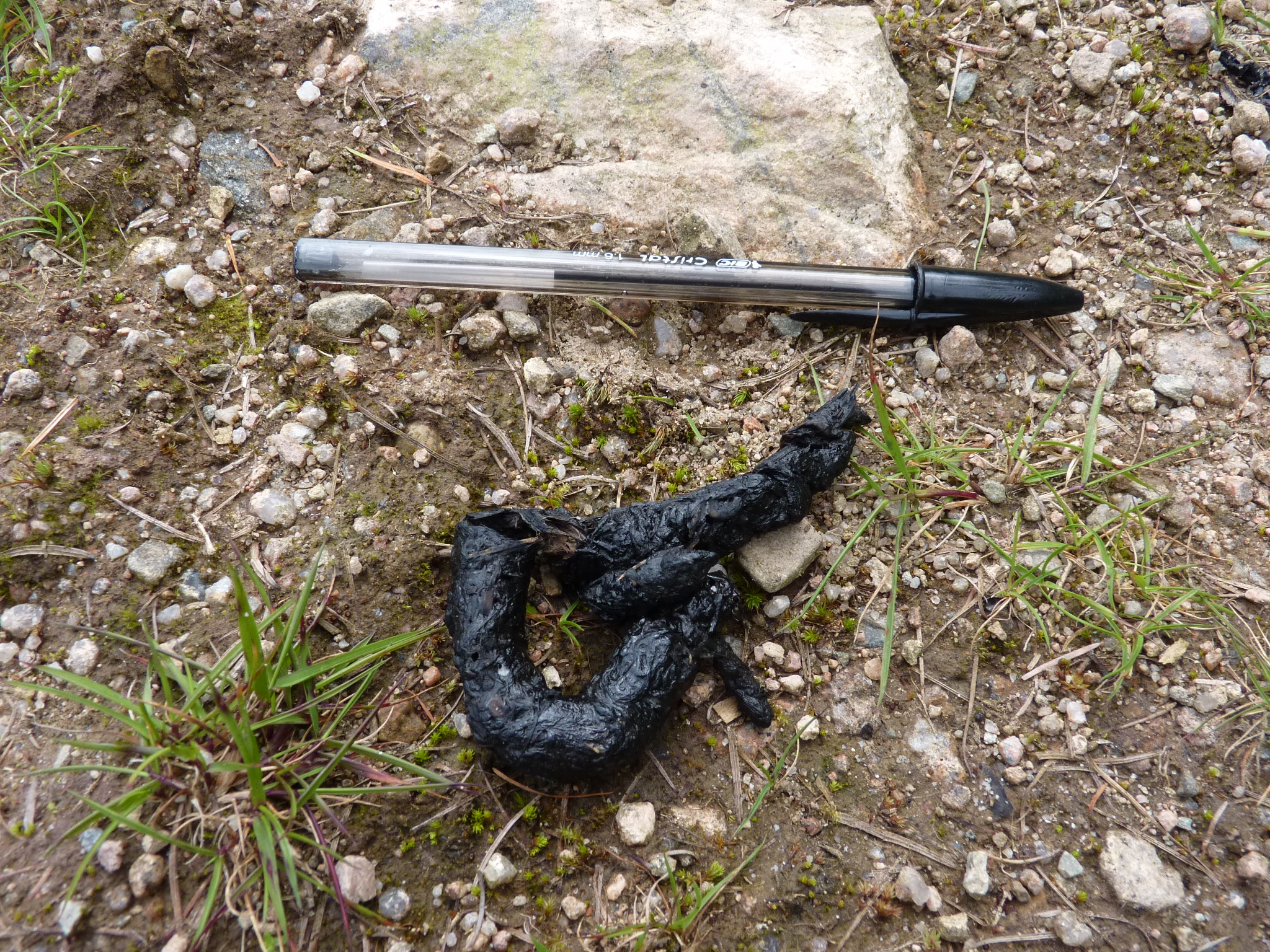
Photo: A pine marten scat ©Lizzie Croose
At the junction of two forest paths, and close to a mountain stream wending its way towards the Rheidol, I discover my first marten scat of the day. In alphabet terms, it is a classic ‘s-shape’ and has been skilfully deposited on a bed of decaying pine needles. I am confident of my find: no musky fox smell, too big for stoat, too fruity for dog. I can see the remains of berries: bilberry perhaps or blackberry. The fur remnants are likely to be rabbit – two-a-penny round here. The scat is also fresh so we should get a good DNA result. It smells of marten, it looks like marten and it was found on the edge of a woodland track. What else could it possibly be?
We stop to collect some hair tubes and cameras. The tubes have been positioned mostly on impossibly steep slopes. To a passing walker, if there should ever be one, these tubes would be seen as sections of orange drainpipe wired vertically to a tree. Should that passing walker take a closer look, they would find, quite intriguingly, that each pipe contains a single chicken wing, with a remote camera pointed at it. Martens have creamy-yellow ‘bibs’ set against their chestnut fur and no two marten bibs have the same pattern. Bib shots from a remote camera are therefore particularly handy when trying to identify a specific marten.
In theory, the marten climbs through the tube to reach the chicken – and leaves some tell-tale hairs behind, but in practice, the martens round here don’t seem to want to put in the work needed to reach the chicken and most are untouched. A whiff of putrid chicken wafts past me and I can completely see where the martens are coming from.
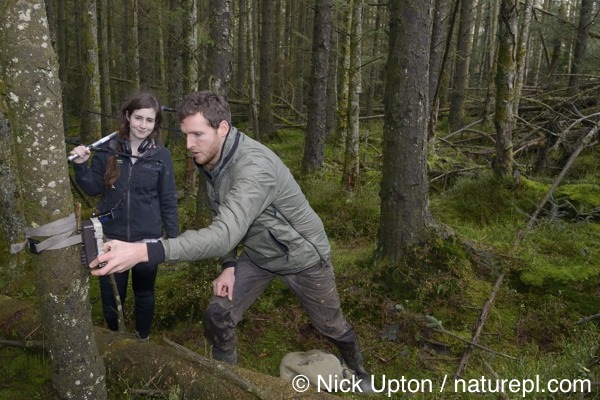
Photo: Checking a camera trap ©Nick Upton
With the cold seeping through our numerous layers of clothing, we take a break and head for the local community Cwtch café. Ostensibly this is to check the remote camera footage but really we need to defrost and enjoy some home cooking.
The first SD card is loaded into the laptop. I have a sense of being watched: this is not one of those slick corporate venues where executives huddle over infographics and drink Americanos. ‘I think it’s PM04.’ My colleague stares at the laptop as if her lottery numbers have just rolled into view. Ungluing myself from the menu, and a little sceptically, I take a look at the screen. Sure enough the camera has captured a marten – running around rather than through the hair tube. It is difficult to articulate the joy at witnessing this event. All nearby conversation stops. Unable to hold back, a couple on the next table come over to see what all the squealing is about.
Pine martens become the talk of the café. An elderly man from the village reminisces about seeing pine martens in his youth. Another visitor tells us he recently saw a marten while out collecting firewood. I’m not sure ‘collecting’ wood is a permissible activity, but I listen enthusiastically to his story. An animated conversation develops around the possible impact martens may have on grey squirrel numbers to the benefit of our beloved red squirrel. Much as I would love to see the alien grey squirrel annihilated, I try not to be drawn into this can of worms.
As my eye is drawn covertly back to the menu, there is a second shriek. A camera collected from another hair tube has captured shots of a young marten – a kit from this season.
I may not have seen a live marten on this trip, but that was always going to be a long shot. I have, however, seen video evidence and that is a real privilege. To know that these animals are not just surviving but thriving is breath-taking. To see the reaction of people in the café is humbling. The locals have welcomed these animals to their woods and the martens have not let them down. Today, a species that was perilously close to extinction in Wales is enjoying a comeback, and the signs are that we now have a viable marten population residing in mid-Wales and adding to the ecological health of these Welsh woodlands.
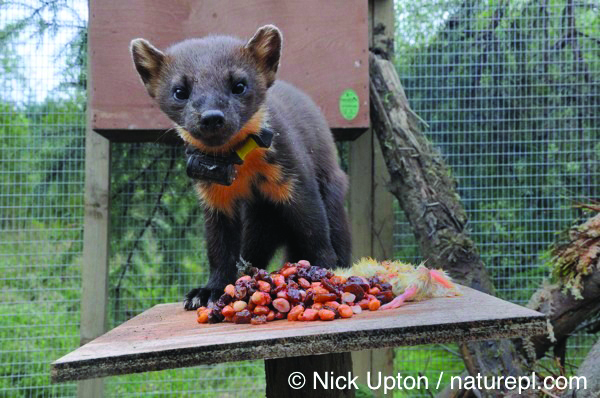
Photo: A pine marten in a release pen prior to being released in mid-Wales ©Nick Upton
With the plethora of gloomy headlines focused on species loss, habitat destruction and the catastrophic impact of climate change, this is one part of the carnivore good news story that I felt I had to share.
Hilary Macmillan, VWT Head of Communications